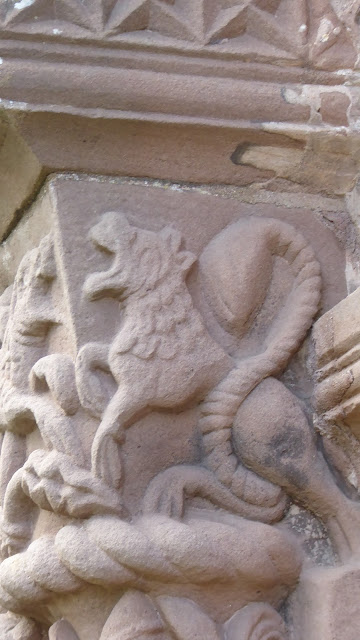Kilpeck is eight miles S-W of Hereford and this is the parish church of St Mary and St David, which has been described as "one of the most perfect Norman village churches in England". It stands beside the remains of the mottle and bailey Norman castle, although little of the castle remain inside the well-defined bailey. This planned pairing of Castle and Church was a standard Norman practice, as they sought to control the populace in mind and body.
There was also a Priory on the site, given by Hugh, lord of Kilpeck Castle.
The church is built from Old Red Sandstone and divided into three spaces - the rounded apse, chancel and nave very similar to the design of the church at Moccas, and the larger four cell church at Peterchurch.
Over the amazingly-carved doorway is this beautiful tympanum, "carved with sparse foliage and grape clusters on striated stems" - this is the Tree of Life (or the tree of good and evil). In the Bestiary it is mentioned that "the perindens is a tree found in India - the fruit of this tree is very sweet andn pleasant, and doves delight in its fruit and live in the tree, feeding on it. The dragon, which is the enemy of doves, fears the tree, because of the shade in which the doves rest, and it can approach neither the tree nor its shadow." Note dragon (or Basilisk according to Thurlby) in the capital at the top . . .
The figures featured entwined in interlace, are knights wearing phrygian caps, what appear to be quilted garments ("striated hauberks" according to the book) and armed with a cross, and below, a sword.
The doorway seen close-to, with below, a close up of that scaredy-cat dragon (or Basilisk):
Below: some happy doves, billing and cooing, and SAFE from the dragon!

A splendid green man on the other capitol.
The carvings on the right pillar.
Here is the "evil lion" . . . "Your adversary the devil, as a roaring lion, walketh about seeking whom he may devour" - Peter (5:8).
Above the typanum is a double arch showing various beasties and carvings, none, I would suggest, being at all whimsical but based on similar adornments found at Hereford and Gloucester Cathedrals,and ultimately to a source in France - Notre-Dame-la-Grande, Poitiers and other French churches, whilst the figures on the south doorway have their parallel echo those found at Mailezais, Vendee.
Beak heads and angels, dragons and manticores, and variations on these, jostle for position. I rather like the "green man" type image which has foliage hanging from his mouth like two unrolled tongues.
The SUPERB decorative ironwork on the door. Some of the nicest I've ever seen.
The stoup looks rather odd, having hands clasped around a portly or pregnant belly and reptilian heads for feet . . . Apparently it is probably pre-Saxon and came from nearby Wormbridge.
I believe these are meant to represent Saints. Their positioning, one on top of another, hints at the influence of similar sculptures at Santiago de Compostella (the gate of Silversmiths).
The semi-circular apse with its wonderful domed roof, which was a sign of Heaven to the early Christians.
Finally today, a nod to the locale with these swags of hops hanging up.






















Wow! Those carvings are gorgeous.
ReplyDeleteThey are just superb. So much skill.
DeleteLovely detailed work. Enjoyed the history you share. :)
ReplyDeleteGlad you enjoyed it Judy. Nice to get my brain active again!
DeleteOh wow! My favourite church of all time - so good to see your images. I am so pleased they still have the dried hops inside. The door and corbels at the church with all the carvings are out of this world. I am so pleased you managed to visit. I have the Thurlby book too it is brilliant although sadly they had none for sale in the church - there was a price but no books so I had to buy it from Amazon.
ReplyDeleteAmazing post and thank you for bringing back so many memories. I must go again one day.
I have this on a par with Kempley,but for different reasons. I think Kempley is so special because of what you feel there, which is amazing. This is just such superb craftsmanship and a fascinating glimpse into the Medieval mind.
DeleteGlad you enjoyed it and I hope you get there again soon.
We visited there three years ago to the week. The Sunday after our Malvern show visit, on the morning we were heading home, before anything was open. Walked round the outside of the church and up the castle mound. Such a special place, untouched by heavy Victorian hand. I guess the seeming remoteness of this part of the county was in its favour. From there we went to Abbey Dore gardens and on to Longtown castle before reluctantly heading back to London.
ReplyDeleteWhat a wonderful last day before going home. I found some photos last night and found it was 15 years since we were last there, so defo. time to revisit!
DeleteThe carvings are wonderful. Thank you for sharing them with us.
ReplyDeleteGod bless.
Lots more to come, Jackie. You have been warned!
DeleteWhat beautiful carvings these are. Thank you for sharing
ReplyDeleteGlad you enjoyed them Tanya. It's a very special place.
ReplyDelete